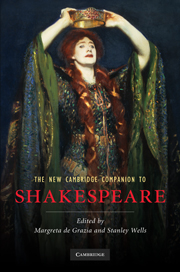Book contents
- Frontmatter
- 1 The traces of Shakespeare’s life
- 2 Shakespeare’s reading
- 3 Shakespeare’s writing: from manuscript to print
- 4 The theatre of Shakespeare’s London
- 5 The transmission of Shakespeare’s texts
- 6 Shakespeare and language
- 7 Shakespeare the poet
- 8 Shakespeare’s comedies
- 9 Shakespeare’s tragedies
- 10 Shakespeare’s English history plays
- 11 Shakespeare’s classical plays
- 12 Shakespeare’s tragicomedies
- 13 Shakespeare, religion and politics
- 14 Shakespeare and race
- 15 Shakespeare, sexuality and gender
- 16 Shakespeare on the stage
- 17 The critical reception of Shakespeare
- 18 Shakespeare and popular culture
- 19 Shakespeare and globalization
- 20 Shakespeare and media history
- 21 Shakespeare: reading on
- Index
20 - Shakespeare and media history
Published online by Cambridge University Press: 28 January 2011
- Frontmatter
- 1 The traces of Shakespeare’s life
- 2 Shakespeare’s reading
- 3 Shakespeare’s writing: from manuscript to print
- 4 The theatre of Shakespeare’s London
- 5 The transmission of Shakespeare’s texts
- 6 Shakespeare and language
- 7 Shakespeare the poet
- 8 Shakespeare’s comedies
- 9 Shakespeare’s tragedies
- 10 Shakespeare’s English history plays
- 11 Shakespeare’s classical plays
- 12 Shakespeare’s tragicomedies
- 13 Shakespeare, religion and politics
- 14 Shakespeare and race
- 15 Shakespeare, sexuality and gender
- 16 Shakespeare on the stage
- 17 The critical reception of Shakespeare
- 18 Shakespeare and popular culture
- 19 Shakespeare and globalization
- 20 Shakespeare and media history
- 21 Shakespeare: reading on
- Index
Summary
The scholar Raymond Bellour once described film as 'an unattainable text', a phrase that has resonated in media studies since 1975, when he wrote it. At the time, the medium of film was largely synonymous with 'cinema', a collective experience in which audiences arrived at designated times to watch a multi-reel screening. For most viewers, movies were screened once and then revisited in memory. Bellour foresaw a different future, when 'film will find . . . a status analogous to that of the book' and individuals may own and access movies at will . Yet even then, he argues, films will remain unattainable in one important respect. For Bellour, the defining property of a 'text' is a specific kind of audience engagement: the ability to quote a text in its own medium, handle it as we do a novel or essay and thus make it imaginatively, aesthetically and intellectually our own. At the time, ordinary movie viewers did not have the ability to handle their movie-going experiences in this way: to interpret, select and re-make them in their own medium, as writers can do with the works of other writers. Many things have changed since Bellour made this argument. New technologies such as DVDs and video-editing stations now allow students to handle and quote clips and digital stills. New genres such as the remix and video mash-up make audio-visual sampling, quotation and interpretation a popular form of artistic play. It remains impossible to quote moving sequences in a paper-and-print essay such as this one. Yet we have drawn closer to Bellour's vision of aesthetic and intellectual access.
- Type
- Chapter
- Information
- The New Cambridge Companion to Shakespeare , pp. 303 - 324Publisher: Cambridge University PressPrint publication year: 2010
- 5
- Cited by



